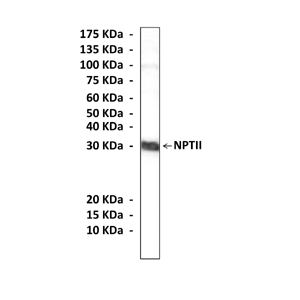Anti-NPTII: Mouse Neomycin Phosphotransferase II Antibody |
 |
BACKGROUND The aminoglycoside phosphotransferases belong to a clinically important group of proteins that enable bacteria to grow in the presence of selected aminoglycoside antibiotics, including kanamycin, neomycin, and G418. These enzymes, which are plasmid or transposon encoded, inactivate the antibiotics by catalyzing the transfer of the terminal phosphate of ATP to the drug.1 Two aminoglycoside phosphotransferase genes are used in selection of transformed organisms: the neomycin phosphotransferase I (nptI) gene and the neomycin phosphotransferase II (nptII) gene. Neomycin phosphotransferase II (NPTII; EC 2.7.1.95) is the most widely used selectable marker in the transformation of organisms including yeast, Dictyostelium discoideum, mammals, and plants. NPTII was initially isolated from the transposon Tn5 that was present in the bacterium strain Escherichia coli K12. NPTII is also used in gene expression and regulation studies in different organisms in part because N-terminal fusions can be constructed that retain enzymatic activity. In animal cells, G418 and neomycin are used as selectable agents.2 The gene is usually modified to contain a promoter and terminator that can function in the recipient host. Cells that receive and properly express such chimeric constructs can be selected by using antibiotic concentrations that inhibit the growth of cells not containing the resistance gene. The aminoglycoside 3'-phosphotransferases exhibit 30-36% amino acid sequence homology except in a region near the carboxyl terminus, where the homology is 60-70%. It has been suggested that the catalytic functions of binding ATP and transferring the terminal phosphate are performed at the more conserved region. The mutation causes reduced NPTII enzyme activity, resulting in a decreased ability of transformants to grow in the presence of elevated concentrations of antibiotic.3
REFERENCES
1. Wright, G.D. & Thompson, P.R.: Front. Biosci. 4:d9-21, 1999
2. Argyle, J.L. et al: Appl. Environ. Microbiol. 62:4233-7, 1996
3. Yenofsky, R.L. et al: Proc. Natl. Acad. Sci. USA 87:3435-9, 1990
2. Argyle, J.L. et al: Appl. Environ. Microbiol. 62:4233-7, 1996
3. Yenofsky, R.L. et al: Proc. Natl. Acad. Sci. USA 87:3435-9, 1990
Products are for research use only. They are not intended for human, animal, or diagnostic applications.
Параметры
Cat.No.: | CP10330 |
Antigen: | Raised against recombinant human NPTII fragments expressed in E. coli. |
Isotype: | Mouse IgG1 |
Species & predicted species cross- reactivity ( ): | E. coli |
Applications & Suggested starting dilutions:* | WB 1:1000 IP 1:50 IHC n/d ICC n/d FACS n/d |
Predicted Molecular Weight of protein: | 30 kDa |
Specificity/Sensitivity: | Detects NPTII proteins without cross-reactivity with other family members. |
Storage: | Store at -20°C, 4°C for frequent use. Avoid repeated freeze-thaw cycles. |
*Optimal working dilutions must be determined by end user.
Документы
Информация представлена исключительно в ознакомительных целях и ни при каких условиях не является публичной офертой








